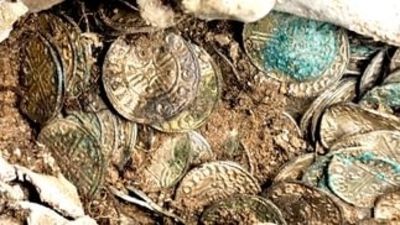'A perfect time capsule': Hoard of 11th-century coins discovered at Sizewell C nuclear power site

A hoard of over 300 mint-condition silver coins has been found near the site of the proposed Sizewell C nuclear power station.
The site's archaeology partner, Oxford Cotswold Archaeology, discovered the lead and cloth package containing the 321 coins which archaeologists have dubbed "the pasty" due to its size.
The bundle may have been a savings pot belonging to a local figure of influence, who buried their wealth because of the uncertainty caused by the coronation of Edward the Confessor in 1042.
Archaeologist Andrew Pegg, who discovered the coins, said the hoard was a "true privilege" to find, adding: "I was shaking when I first unearthed it, seeing a single coin edge peeking at me.
"A perfect archaeological time capsule.
"The information we are learning from it is stunning and I'm so proud to have added to the history of my own little part of Suffolk."
Many of the coins were minted in London, but others were struck in Thetford in Norfolk, Norwich and Ipswich between 1036 and 1044.
At the time, they would have been worth the same as a small herd of cows.
Edward the Confessor's coronation followed 25 years of rule by the Danish king Cnut and his two sons, with wealthy people associated with the previous regime being exiled or having their property confiscated.
Damian Leydon, site delivery director at Sizewell C, called the hoard "extraordinary" and said the site would work with OCA to make any discoveries as accessible to the public as possible.
Want a quick and expert briefing on the biggest news stories? Listen to our latest podcasts to find out What You Need To Know